Radiomics and Deep Features: Robust Classification of Brain Hemorrhages and Reproducibility Analysis Using a 3D Autoencoder Neural Network
- PMID: 39061725
- PMCID: PMC11273742
- DOI: 10.3390/bioengineering11070643
Radiomics and Deep Features: Robust Classification of Brain Hemorrhages and Reproducibility Analysis Using a 3D Autoencoder Neural Network
Abstract
This study evaluates the reproducibility of machine learning models that integrate radiomics and deep features (features extracted from a 3D autoencoder neural network) to classify various brain hemorrhages effectively. Using a dataset of 720 patients, we extracted 215 radiomics features (RFs) and 15,680 deep features (DFs) from CT brain images. With rigorous screening based on Intraclass Correlation Coefficient thresholds (>0.75), we identified 135 RFs and 1054 DFs for analysis. Feature selection techniques such as Boruta, Recursive Feature Elimination (RFE), XGBoost, and ExtraTreesClassifier were utilized alongside 11 classifiers, including AdaBoost, CatBoost, Decision Trees, LightGBM, Logistic Regression, Naive Bayes, Neural Networks, Random Forest, Support Vector Machines (SVM), and k-Nearest Neighbors (k-NN). Evaluation metrics included Area Under the Curve (AUC), Accuracy (ACC), Sensitivity (SEN), and F1-score. The model evaluation involved hyperparameter optimization, a 70:30 train-test split, and bootstrapping, further validated with the Wilcoxon signed-rank test and q-values. Notably, DFs showed higher accuracy. In the case of RFs, the Boruta + SVM combination emerged as the optimal model for AUC, ACC, and SEN, while XGBoost + Random Forest excelled in F1-score. Specifically, RFs achieved AUC, ACC, SEN, and F1-scores of 0.89, 0.85, 0.82, and 0.80, respectively. Among DFs, the ExtraTreesClassifier + Naive Bayes combination demonstrated remarkable performance, attaining an AUC of 0.96, ACC of 0.93, SEN of 0.92, and an F1-score of 0.92. Distinguished models in the RF category included SVM with Boruta, Logistic Regression with XGBoost, SVM with ExtraTreesClassifier, CatBoost with XGBoost, and Random Forest with XGBoost, each yielding significant q-values of 42. In the DFs realm, ExtraTreesClassifier + Naive Bayes, ExtraTreesClassifier + Random Forest, and Boruta + k-NN exhibited robustness, with 43, 43, and 41 significant q-values, respectively. This investigation underscores the potential of synergizing DFs with machine learning models to serve as valuable screening tools, thereby enhancing the interpretation of head CT scans for patients with brain hemorrhages.
Keywords: brain; deep features; hemorrhage; machine learning; radiomics features; reproducible.
Conflict of interest statement
The authors declare no conflicts of interest.
Figures

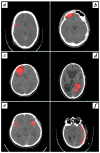




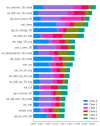
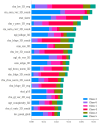
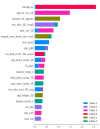


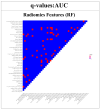
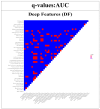
Similar articles
-
Enhancing brain tumor classification by integrating radiomics and deep learning features: A comprehensive study utilizing ensemble methods on MRI scans.J Xray Sci Technol. 2025 Jan;33(1):47-57. doi: 10.1177/08953996241299996. Epub 2024 Dec 9. J Xray Sci Technol. 2025. PMID: 39973780
-
Prediction and feature selection of low birth weight using machine learning algorithms.J Health Popul Nutr. 2024 Oct 12;43(1):157. doi: 10.1186/s41043-024-00647-8. J Health Popul Nutr. 2024. PMID: 39396025 Free PMC article.
-
PET radiomics-based lymphovascular invasion prediction in lung cancer using multiple segmentation and multi-machine learning algorithms.Phys Eng Sci Med. 2024 Dec;47(4):1613-1625. doi: 10.1007/s13246-024-01475-0. Epub 2024 Sep 3. Phys Eng Sci Med. 2024. PMID: 39225775 Free PMC article.
-
Artificial intelligence in clinical care amidst COVID-19 pandemic: A systematic review.Comput Struct Biotechnol J. 2021;19:2833-2850. doi: 10.1016/j.csbj.2021.05.010. Epub 2021 May 7. Comput Struct Biotechnol J. 2021. PMID: 34025952 Free PMC article. Review.
-
COVID-19 diagnosis: A comprehensive review of pre-trained deep learning models based on feature extraction algorithm.Results Eng. 2023 Jun;18:101020. doi: 10.1016/j.rineng.2023.101020. Epub 2023 Mar 16. Results Eng. 2023. PMID: 36945336 Free PMC article. Review.
Cited by
-
Development and validation of intracranial hypertension prediction models based on radiomic features in patients with traumatic brain injury: an exploratory study based on CENTER-TBI data.Crit Care. 2025 Mar 6;29(1):100. doi: 10.1186/s13054-025-05328-4. Crit Care. 2025. PMID: 40050978 Free PMC article.
-
Automated classification of chondroid tumor using 3D U-Net and radiomics with deep features.Sci Rep. 2025 Jul 1;15(1):20389. doi: 10.1038/s41598-025-07128-w. Sci Rep. 2025. PMID: 40594673 Free PMC article.
-
A comparative study of machine learning models for predicting neoadjuvant chemoradiotheraphy response in rectal cancer patients using radiomics and clinical features.Medicine (Baltimore). 2025 Jul 4;104(27):e43173. doi: 10.1097/MD.0000000000043173. Medicine (Baltimore). 2025. PMID: 40629575 Free PMC article.
-
Advanced machine learning framework for enhancing breast cancer diagnostics through transcriptomic profiling.Discov Oncol. 2025 Mar 17;16(1):334. doi: 10.1007/s12672-025-02111-3. Discov Oncol. 2025. PMID: 40095253 Free PMC article.
-
Comparative analysis of convolutional neural networks and vision transformers in identifying benign and malignant breast lesions.Medicine (Baltimore). 2025 Jun 6;104(23):e42683. doi: 10.1097/MD.0000000000042683. Medicine (Baltimore). 2025. PMID: 40489850 Free PMC article.
References
LinkOut - more resources
Full Text Sources

